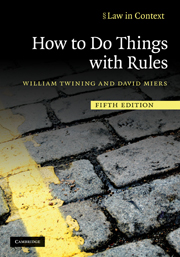Book contents
- Frontmatter
- Contents
- Preface
- Online appendices
- Acknowledgements
- Abbreviations
- Table of statutes and legislative instruments
- Table of cases
- Part I
- Part II Reading, using and interpreting rules in general
- 2 Problems and mischiefs
- 3 Of rules in general
- 4 Interpretation and application
- 5 Imperfect rules
- Part III Reading law: reading, using and interpreting legislation and cases
- Part IV
- Index
- Resources on the web
- References
5 - Imperfect rules
Published online by Cambridge University Press: 05 June 2012
- Frontmatter
- Contents
- Preface
- Online appendices
- Acknowledgements
- Abbreviations
- Table of statutes and legislative instruments
- Table of cases
- Part I
- Part II Reading, using and interpreting rules in general
- 2 Problems and mischiefs
- 3 Of rules in general
- 4 Interpretation and application
- 5 Imperfect rules
- Part III Reading law: reading, using and interpreting legislation and cases
- Part IV
- Index
- Resources on the web
- References
Summary
Someone asked to describe her model of a technically perfect rule might reply: A rule is perfect if (a) it has a single clear and acceptable aim; (b) it is so clearly and precisely expressed that it leaves no room for doubt about its application in any possible case, and no loopholes for those who might wish to escape its effects; (c) its scope is coextensive with its purpose; and (d) it is certain to achieve its purpose without undesirable side effects.
In a famous passage in The Concept of Law, Hart outlined some of the reasons why this is not only unattainable, but also undesirable as a model for all legal rules:
Whichever device, precedent or legislation, is chosen for the communication of standards of behaviour, these, however smoothly they work over the great mass of ordinary cases, will, at some point where their application is in question, prove indeterminate; they will have what has been termed an open texture. So far we have presented this, in the case of legislation, as a general feature of human language; uncertainty at the borderline is the price to be paid for the use of general classifying terms in any form of communication concerning matters of fact. Natural languages like English are when so used irreducibly open textured. It is, however, important to appreciate why, apart from this dependence on language as it actually is, with its characteristics of open texture, we should not cherish, even as an ideal, the conception of a rule so detailed that the question whether it applied or not to a particular case was always settled in advance, and never involved, at the point of actual application, a fresh choice between open alternatives. […]
- Type
- Chapter
- Information
- How to Do Things with Rules , pp. 148 - 172Publisher: Cambridge University PressPrint publication year: 2010

